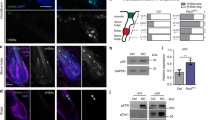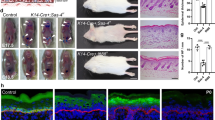Abstract
Planar cell polarity (PCP) is the collective polarization of cells along the epithelial plane, a process best understood in the terminally differentiated Drosophila wing. Proliferative tissues such as mammalian skin also show PCP, but the mechanisms that preserve tissue polarity during proliferation are not understood. During mitosis, asymmetrically distributed PCP components risk mislocalization or unequal inheritance, which could have profound consequences for the long-range propagation of polarity. Here, we show that when mouse epidermal basal progenitors divide PCP components are selectively internalized into endosomes, which are inherited equally by daughter cells. Following mitosis, PCP proteins are recycled to the cell surface, where asymmetry is re-established by a process reliant on neighbouring PCP. A cytoplasmic dileucine motif governs mitotic internalization of atypical cadherin Celsr1, which recruits Vang2 and Fzd6 to endosomes. Moreover, embryos transgenic for a Celsr1 that cannot mitotically internalize exhibit perturbed hair-follicle angling, a hallmark of defective PCP. This underscores the physiological relevance and importance of this mechanism for regulating polarity during cell division.
This is a preview of subscription content, access via your institution
Access options
Subscribe to this journal
Receive 12 print issues and online access
$209.00 per year
only $17.42 per issue
Buy this article
- Purchase on Springer Link
- Instant access to full article PDF
Prices may be subject to local taxes which are calculated during checkout






Similar content being viewed by others
Change history
12 January 2017
In the version of this Article originally published, Supplementary Figure 4c portrayed normal mitotic internalization of a Celsr1ΔNSTTTTS–GFP mutant plasmid. Resequencing revealed an error in the sequence of this construct. Supplementary Figure 4c now shows representative images of keratinocytes expressing a construct harbouring the correct sequence of this mutant. The bona fide mutant shows reduced mitotic internalization compared with the wild-type control. This error does not affect the data presented in the main paper, nor does it change the major conclusions drawn. Additionally, in light of this error, all of the other sequences of constructs used in this study were verified. Supplementary Figure 4 has been corrected in the online versions of the Article and the text describing these data on page 897 has been changed accordingly.
References
Guo, N., Hawkins, C. & Nathans, J. Frizzled6 controls hair patterning in mice. Proc. Natl Acad. Sci. USA 101, 9277–9281 (2004).
Devenport, D. & Fuchs, E. Planar polarization in embryonic epidermis orchestrates global asymmetric morphogenesis of hair follicles. Nat. Cell Biol. 10, 1257–1268 (2008).
Simons, M. & Mlodzik, M. Planar cell polarity signaling: from fly development to human disease. Annu. Rev. Genet. 42, 517–540 (2008).
Strutt, D. I. Asymmetric localization of frizzled and the establishment of cell polarity in the Drosophila wing. Mol. Cell 7, 367–375 (2001).
Bastock, R., Strutt, H. & Strutt, D. Strabismus is asymmetrically localised and binds to Prickle and Dishevelled during Drosophila planar polarity patterning. Development 130, 3007–3014 (2003).
Usui, T. et al. Flamingo, a seven-pass transmembrane cadherin, regulates planar cell polarity under the control of Frizzled. Cell 98, 585–595 (1999).
Axelrod, J. D. Unipolar membrane association of Dishevelled mediates Frizzled planar cell polarity signaling. Genes Dev. 15, 1182–1187 (2001).
Tree, D. R. et al. Prickle mediates feedback amplification to generate asymmetric planar cell polarity signaling. Cell 109, 371–381 (2002).
Montcouquiol, M. et al. Asymmetric localization of Vangl2 and Fz3 indicate novel mechanisms for planar cell polarity in mammals. J. Neurosci. 26, 5265–5275 (2006).
Wang, Y., Guo, N. & Nathans, J. The role of Frizzled3 and Frizzled6 in neural tube closure and in the planar polarity of inner-ear sensory hair cells. J. Neurosci. 26, 2147–2156 (2006).
Wang, J. et al. Regulation of polarized extension and planar cell polarity in the cochlea by the vertebrate PCP pathway. Nat. Genet. 37, 980–985 (2005).
Deans, M. R. et al. Asymmetric distribution of prickle-like 2 reveals an early underlying polarization of vestibular sensory epithelia in the inner ear. J. Neurosci. 27, 3139–3147 (2007).
Vinson, C. R. & Adler, P. N. Directional non-cell autonomy and the transmission of polarity information by the frizzled gene of Drosophila. Nature 329, 549–551 (1987).
Taylor, J., Abramova, N., Charlton, J. & Adler, P. N. Van Gogh: a new Drosophila tissue polarity gene. Genetics 150, 199–210 (1998).
Lawrence, P. A., Casal, J. & Struhl, G. Cell interactions and planar polarity in the abdominal epidermis of Drosophila. Development 131, 4651–4664 (2004).
Strutt, D. & Strutt, H. Differential activities of the core planar polarity proteins during Drosophila wing patterning. Dev Biol. 302, 181–194 (2007).
Wang, Y., Badea, T. & Nathans, J. Order from disorder: self-organizationin mammalian hair patterning. Proc. Natl Acad. Sci. USA 103, 19800–19805 (2006).
Strutt, H. & Strutt, D. Differential stability of flamingo protein complexes underlies the establishment of planar polarity. Curr. Biol. 18, 1555–1564 (2008).
Baker, J. & Garrod, D. Epithelial cells retain junctions during mitosis. J. Cell Sci. 104, 415–425 (1993).
Reinsch, S. & Karsenti, E. Orientation of spindle axis and distribution of plasma membrane proteins during cell division in polarized MDCKII cells. J. Cell Biol. 126, 1509–1526 (1994).
Smart, I. H. Variation in the plane of cell cleavage during the process of stratification in the mouse epidermis. Br. J. Dermatol. 82, 276–282 (1970).
Lechler, T. & Fuchs, E. Asymmetric cell divisions promote stratification and differentiation of mammalian skin. Nature 437, 275–280 (2005).
Zerial, M. & McBride, H. Rab proteins as membrane organizers. Nat. Rev. Mol. Cell Biol. 2, 107–117 (2001).
Boucrot, E. & Kirchhausen, T. Endosomal recycling controls plasma membrane area during mitosis. Proc. Natl Acad. Sci. USA 104, 7939–7944 (2007).
Bonifacino, J. S. & Traub, L. M. Signals for sorting of transmembrane proteins to endosomes and lysosomes. Annu. Rev. Biochem. 72, 395–447 (2003).
Chen, W. S. et al. Asymmetric homotypic interactions of the atypical cadherin flamingo mediate intercellular polarity signaling. Cell 133, 1093–1105 (2008).
Wu, J. & Mlodzik, M. The frizzled extracellular domain is a ligand for Van Gogh/Stbm during nonautonomous planar cell polarity signaling. Dev. Cell 15, 462–469 (2008).
Wu, J. & Mlodzik, M. A quest for the mechanism regulating global planar cell polarity of tissues. Trends Cell Biol. 19, 295–305 (2009).
Fernandez-Minan, A., Martin-Bermudo, M. D. & Gonzalez-Reyes, A. Integrin signaling regulates spindle orientation in Drosophila to preserve the follicular-epithelium monolayer. Curr. Biol. 17, 683–688 (2007).
Jaffe, A. B., Kaji, N., Durgan, J. & Hall, A. Cdc42 controls spindle orientation to position the apical surface during epithelial morphogenesis. J. Cell Biol. 183, 625–633 (2008).
Siller, K. H. & Doe, C. Q. Spindle orientation during asymmetric cell division. Nat. Cell Biol. 11, 365–374 (2009).
Segalen, M. & Bellaiche, Y. Cell division orientation and planar cell polarity pathways. Semin. Cell Dev. Biol. 20, 972–977 (2009).
Gho, M. & Schweisguth, F. Frizzled signalling controls orientation ofasymmetric sense organ precursor cell divisions in Drosophila. Nature 393, 178–181 (1998).
Lu, B., Usui, T., Uemura, T., Jan, L. & Jan, Y. N. Flamingo controls the planar polarity of sensory bristles and asymmetric division of sensory organ precursors in Drosophila. Curr. Biol. 9, 1247–1250 (1999).
Bellaiche, Y., Beaudoin-Massiani, O., Stuttem, I. & Schweisguth, F. The planar cell polarity protein Strabismus promotes Pins anterior localization during asymmetric division of sensory organ precursor cells in Drosophila. Development 131, 469–478 (2004).
Aigouy, B. et al. Cell flow reorients the axis of planar polarity in the wing epithelium of Drosophila. Cell 142, 773–786 (2010).
Acknowledgements
We thank N. Stokes for her assistance in the mouse facility, M. Montcouquoil for Vangl2 antibodies, and E. Vladar and J. Axelrod for sharing the lenti-Celsr1ΔN–GFP construct. We thank S. Simon laboratory members L. Macro and C. Atkinson for advice and constructs for TIRF imaging. We are grateful to S. Williams for retroviral vectors and technical assistance and to B. Short and members of the Fuchs laboratory for discussions and reading of the manuscript. We thank A. North and K. Thomas at the RU Bioimaging Resource Center for assistance with image acquisition, and the Comparative Biology Center (CBC) for their help in veterinary care. D.D. is the recipient of a K99 Award from the National Institutes of Health. E.F. is an investigator in the Howard Hughes Medical Institute. Work was supported by the Howard Hughes Medical Institute and the National Institutes of Health.
Author information
Authors and Affiliations
Contributions
E.F. and D.D. designed experiments. D.D. carried out the experiments and analysed their raw data. D.O. carried out injections for generation of transgenic founder animals. E.H. carried out quantitative analyses of image data in Fig. 3. D.D. and E.F. wrote the paper.
Corresponding author
Ethics declarations
Competing interests
The authors declare no competing financial interests.
Supplementary information
Supplementary Information
Supplementary Information (PDF 22572 kb)
Supplementary Movie 1
Supplementary Information (MOV 5875 kb)
Supplementary Movie 2
Supplementary Information (MOV 14086 kb)
Supplementary Movie 3
Supplementary Information (MOV 23124 kb)
Supplementary Movie 4
Supplementary Information (MOV 21755 kb)
Supplementary Movie 5
Supplementary Information (MOV 10275 kb)
Rights and permissions
About this article
Cite this article
Devenport, D., Oristian, D., Heller, E. et al. Mitotic internalization of planar cell polarity proteins preserves tissue polarity. Nat Cell Biol 13, 893–902 (2011). https://doi.org/10.1038/ncb2284
Received:
Accepted:
Published:
Issue Date:
DOI: https://doi.org/10.1038/ncb2284
This article is cited by
-
Live imaging and conditional disruption of native PCP activity using endogenously tagged zebrafish sfGFP-Vangl2
Nature Communications (2022)
-
VANGL2 regulates luminal epithelial organization and cell turnover in the mammary gland
Scientific Reports (2019)
-
PCP and Wnt pathway components act in parallel during zebrafish mechanosensory hair cell orientation
Nature Communications (2019)
-
Membrane-association of EMR2/ADGRE2-NTF is regulated by site-specific N-glycosylation
Scientific Reports (2018)
-
Intracellular trafficking of planar cell polarity proteins
Frontiers in Biology (2018)



